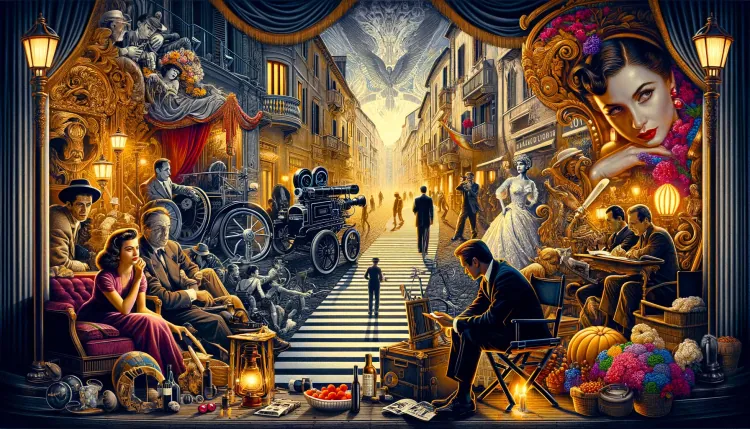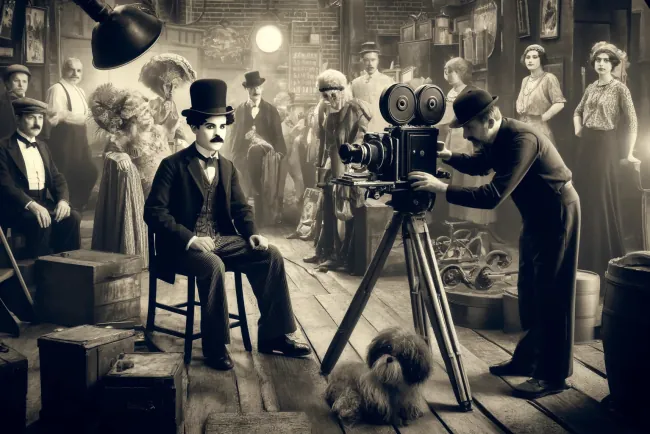Italian Cinema Through the Ages: A Historical Journey
The evolution of Italian cinema from its early pioneering days to the modern era, showcasing its influence on global film

-
Introduction
- Importance of Italian cinema in global film history.
-
Beginnings: Early Italian Cinema
- Early 1900s: The inception and pioneering days.
- Significance of films like "Cabiria" in setting cinematic standards.
-
Italian Neorealism: A New Direction
- Post-WWII realities and the birth of Neorealism.
- Impact of directors like Vittorio De Sica and Roberto Rossellini.
- Key features of Neorealism: on-location shooting, real-life scenarios.
-
The Golden Age: Glamour and Artistry
- Transition to more artistic and surreal storytelling in the 1950s and 1960s.
- Contributions of Federico Fellini and Michelangelo Antonioni.
- Themes of existential angst and modern life.
-
Political Cinema and Beyond
- The politically charged cinema of the 1970s and 1980s.
- Influential works by Bernardo Bertolucci and Pier Paolo Pasolini.
-
Contemporary Italian Cinema
- The diversity and quality of modern Italian films.
- Notable contemporary filmmakers like Paolo Sorrentino and Matteo Garrone.
- Successes in international cinema, including Oscar-winning films.
-
Conclusion
- Summary of the enduring influence and uniqueness of Italian cinema.
-
FAQs
- What defines Italian Neorealism?
- How has Italian cinema influenced global filmmaking?
- Who are some prominent contemporary Italian filmmakers?
Introduction Italian cinema, with its lush landscapes and profound storytelling, has long been a cornerstone in the evolution of global cinema. From its early days in the silent movie era to its influential role during Italian Neorealism, and through to the modern cinematic landscape, Italian films have consistently provided rich narratives and aesthetic innovations.
Beginnings: Early Italian Cinema Italian cinema traces its origins to the early 1900s when Italy was among the first to explore the new medium of film. Pioneers like Filoteo Alberini set the stage with the invention of the movie camera and projector. The 1914 film "Cabiria" by Giovanni Pastrone, known for its grand scale and complex storytelling, was a significant early influence, highlighting the potential of cinema as an epic narrative medium.
Italian Neorealism: A New Direction After World War II, Italian Neorealism emerged, reflecting the stark realities faced by ordinary Italians. This movement shifted away from the fantasy elements of previous films, opting instead for shooting on location and focusing on everyday struggles. Directors like Vittorio De Sica, with his film "Bicycle Thieves," and Roberto Rossellini, with "Rome, Open City," introduced a new level of emotional depth and realism that would profoundly influence filmmakers around the world.
The Golden Age: Glamour and Artistry In the 1950s and 1960s, Italian cinema entered what many consider its Golden Age. Filmmakers like Federico Fellini and Michelangelo Antonioni gained international acclaim for their films, which melded surreal storytelling with sharp social commentary. Fellini's "La Dolce Vita" and "8½" are quintessential examples of this era, exploring themes of fame, existential crisis, and the absurdity of modern life with innovative narrative techniques and visual experimentation.
Political Cinema and Beyond The 1970s and 1980s saw Italian cinema adopt a more political tone. Filmmakers such as Bernardo Bertolucci and Pier Paolo Pasolini tackled controversial subjects and societal norms, pushing the boundaries of content and thematic exploration. Films like Bertolucci's "The Conformist" and Pasolini’s "Salò" were not just films; they were political statements that challenged viewers and the industry alike.
Contemporary Italian Cinema Today, Italian cinema continues to be marked by its diversity and the quality of its output. Contemporary filmmakers like Paolo Sorrentino and Matteo Garrone have sustained the tradition of compelling storytelling. Sorrentino's "The Great Beauty," which won an Oscar for Best Foreign Language Film, underscores the persistent vitality and allure of Italian cinema on the global stage.
Conclusion Italian cinema's historical journey is as dramatic and complex as the stories it tells. From pioneering early film techniques to influencing major cinematic movements and capturing the imaginations of audiences worldwide, Italian cinema remains a pivotal element of the international film landscape, continually demonstrating the power of film to reflect and reshape our understanding of life.
FAQs
- What defines Italian Neorealism?
- Italian Neorealism is characterized by its focus on everyday life, use of non-professional actors, and filming on location, aiming to reflect the socio-economic realities of post-war Italy.
- How has Italian cinema influenced global filmmaking?
- Italian cinema, particularly through movements like Neorealism and the artistic films of the Golden Age, has influenced narrative techniques, thematic depth, and aesthetic approaches in global filmmaking.
- Who are some prominent contemporary Italian filmmakers?
- Notable contemporary Italian filmmakers include Paolo Sorrentino, known for his film "The Great Beauty," and Matteo Garrone, recognized for "Gomorrah" and "Tale of Tales."
Explore the rich tapestry of Italian cinema and its impact on film at Kiksee Magazine.
What's Your Reaction?






















